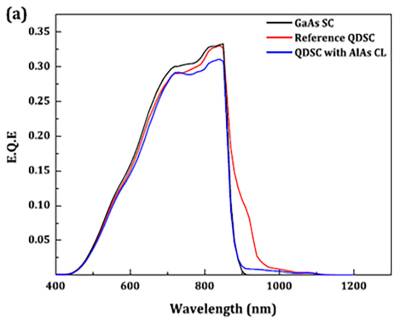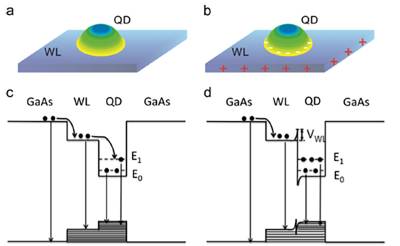Since the concept of the intermediate band solar cell (IBSC) was proposed in 1997, a significant effort has been made to realise IBSCs with efficiencies that exceed the Shockley-Queisser limit of 31 % [1] and reach the theoretical limit of 63.2 % [2]. However, there have been several challenges in implementing high-efficiency quantum dot intermediate band solar cell (QD-IBSC), namely, thermal decoupling between the intermediate band (IB) and the conduction band (CB), reduction of strain-induced dislocations of QDs, suppression of carrier recombination, and partial filling of IB.
We have demonstrated that thermal decoupling between the IB and the CB can be achieved by wetting layer (WL) removal by depositing AlAs cap layers (CLs) on QDs (Figure 1) [3], introducing a potential barrier between QDs and WLs via Si doping (Figure 2) [4], and enhancing CB offset by hosting QDs within high bandgap material [5]. For suppression of the accumulated strain from the QDs that leads to the formation of threading dislocations, the growth of a high-growth temperature GaAs spacer layer have been demonstrated [7]. Type-II band alignment has also been investigated to reduce carrier recombination a by spatially separating the photo-excited charge carriers [8]. Further work is being carried out in order to achieve partial filling of the IB for strong sub-bandgap photon absorption.
[1] W. Shockley and H. J. Queisser, ‘Detailed Balance Limit of Efficiency of p‐n Junction Solar Cells’, J. Appl. Phys., vol. 32, no. 3, pp. 510–519, Mar. 1961.
[2] A. Luque, A. Martí, and C. Stanley, ‘Understanding intermediate-band solar cells’, Nat. Photonics, vol. 6, no. 3, pp. 146–152, Mar. 2012.
[3] F. K. Tutu, P. Lam, J. Wu, N. Miyashita, Y. Okada, K.-H. Lee, N. J. Ekins-Daukes, J. Wilson, and H. Liu, ‘InAs/GaAs quantum dot solar cell with an AlAs cap layer’, Appl. Phys. Lett., vol. 102, no. 16, p. 163907, Apr. 2013.
[4] P. Lam, S. Hatch, J. Wu, M. Tang, V. G. Dorogan, Y. I. Mazur, G. J. Salamo, I. Ramiro, A. Seeds, and H. Liu, ‘Voltage recovery in charged InAs/GaAs quantum dot solar cells’, Nano Energy, vol. 6, pp. 159–166, May 2014.
[5] P. Lam, J. Wu, M. Tang, D. Kim, S. Hatch, I. Ramiro, V. G. Dorogan, M. Benamara, Y. I. Mazur, G. J. Salamo, J. Wilson, R. Allison, and H. Liu, ‘InAs/InGaP quantum dot solar cells with an AlGaAs interlayer’, Sol. Energy Mater. Sol. Cells, vol. 144, pp. 96–101, Jan. 2016.
[6] H. Y. Liu, I. R. Sellers, T. J. Badcock, D. J. Mowbray, M. S. Skolnick, K. M. Groom, M. Gutiérrez, M. Hopkinson, J. S. Ng, J. P. R. David, and R. Beanland, ‘Improved performance of 1.3μm multilayer InAs quantum-dot lasers using a high-growth-temperature GaAs spacer layer’, Appl. Phys. Lett., vol. 85, no. 5, pp. 704–706, Aug. 2004.
[7] F. K. Tutu, I. R. Sellers, M. G. Peinado, C. E. Pastore, S. M. Willis, A. R. Watt, T. Wang, and H. Y. Liu, ‘Improved performance of multilayer InAs/GaAs quantum-dot solar cells using a high-growth-temperature GaAs spacer layer’, J. Appl. Phys., vol. 111, no. 4, p. 046101, Feb. 2012.
[8] S. Hatch, J. Wu, K. Sablon, P. Lam, M. Tang, Q. Jiang, and H. Liu, ‘InAs/GaAsSb quantum dot solar cells’, Opt. Express, vol. 22, no. S3, pp. A679–A685, May 2014.
 Close
Close



![Current density vs. voltage curves for the InAs/GaAs QDSCs with and without AlAs CL, and the GaAs reference solar cell under 1-sun AM1.5 illumination [3].](https://www.ucl.ac.uk/electronic-electrical-engineering/sites/electronic_electrical_engineering/files/styles/medium_image/public/mbe-research-9a.jpg?itok=B7Wj1KLh)
